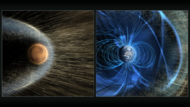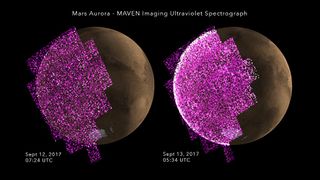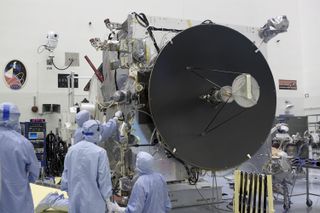MAVEN
| This article is about a technology that is currently under development. Details may change at any time. Please remove this template when it is fully developed. |
MAVEN stands for Mars Atmosphere and Volatile EvolutioN. It is a planned orbiter that will study the evolution of the martian atmosphere.
MAVEN stands for NASA’s Mars Atmosphere and Volatile EvolutioN mission. It was launched in November 18, 2013 to examine Mars’s upper atmosphere, ionosphere and interactions with the sun and solar wind. [1] [2] MAVEN was placed into orbit on September 21, 2014; in its highly elliptical orbit it travels out to 3,900 miles (6,200 km) then comes in as close as 93 miles (150 km). Each orbit of the planet takes 4.5 hours. With such a large elliptical orbit it can study different parts of the Martian atmosphere.[3]
Contents
Spacecraft
MAVEN is 37.5 feet (11.4 meters) long and has a mass of 1991 pounds max (903 kilograms) when empty and a mass of 5622 pounds max (2550 kilograms) at launch. Its solar cells provide 1135 watts of power at Mars when Mars is furthest from the Sun.[4]
Instruments
Magnetometer Neutral Gas and Ion Mass Spectrometer Langmuir Probe and Waves Imaging Ultraviolet Spectrometer Solar Wind Electron Analyzer Solar Wind Ion Analyzer Solar Energetic Particles SupraThermal And Thermal Ion Composition[5]
Findings
Of major significance was that MAVEN discovered how Mars lost most of its atmosphere into space. "We've determined that most of the gas ever present in the Mars atmosphere has been lost to space," said Bruce Jakosky, lead author of a paper published in Science. [6] His team’s study was based upon two different isotopes of argon gas.[7] [8] Argon gas is inert, it does not react with anything; hence, it is a good marker of how the atmosphere changed. The heavy form of argon is not lost to space as easily as the lighter variety. A larger proportion of heavy isotope on the planet means that more of the gas has disappeared. The ratio of the heavier Ar38 to the lighter Ar36, means that 65% of argon has left the planet. The main way that argon left the atmosphere was through a process called “sputtering.” Sputtering is a complex method in which the sun strips atmosphere from a planet. The sun is constantly shooting out particles at high speed. If one hits a gas particle in the atmosphere, it may directly knock it into space. Alternatively, it would cause an atom of atmosphere to lose an electron and thereby become an ion. Ions can interact with the sun’s magnetic field as it moves through space. The sun’s magnetic field can sweep them away. In addition ions may hit other atoms in the atmosphere, knocking them into space, as well.[9] This finding that Mars has lost a great deal of its atmosphere, especially water is consistent with several other studies .[10] [11] [12] [13] [14] [15] [16] Although Mars is cold and dry today, it may have been warmer with a thicker atmosphere and liquid water. Observations over many years from orbiting satellites have seen what looks like streams, rivers, and lakes on the surface. [17] [18] [19] [20] [21] [22] [23] [24] [25] There is even evidence for an ocean in the past. [26] [27] [28] [29] MAVEN and other missions are showing how Mars could have lost most of its atmosphere.
In September 2017, MAVEN observed an aurora25 times brighter than any observed earlier, due to a massive, and unexpected, Coronal mass ejection (solar storm).[30]
Additional Duties
Besides studying the atmosphere with a variety of instruments from close and far distances, MAVEN greatly helps with the study of Mars by serving as a relay station between spacecraft on the Martian surface and NASA scientists on the Earth. A probe on the surface would need to wait many hours to send back information when the planet is turned away from the Earth. Much time is saved by using orbiting satellites to pick up and send data from the surface to Earth.
Just by chance just after MAVEN went into orbit, comet C/2013 A1 Siding Spring on October 19, 2014 went by Mars.[31] It took an ultraviolet image of the hydrogen around the comet. The cloud of hydrogen gas was about the same size as our moon as viewed from the Earth.[32] As the comet came close, it was studied with MAVEN’s magnetometer (MAG), the Langmuir Probe and Waves (LPW) instrument, and the Solar Energetic Particles (SEP).[33]
References
- ↑ https://www.nasa.gov/mission_pages/maven/overview/index.html
- ↑ https://mars.nasa.gov/maven/
- ↑ https://en.wikipedia.org/wiki/MAVEN
- ↑ https://www.nasa.gov/sites/default/files/files/MAVENFactSheet_Final20130610.pdf
- ↑ https://www.nasa.gov/mission_pages/maven/overview/index.html
- ↑ https://www.nasa.gov/press-release/nasas-maven-reveals-most-of-mars-atmosphere-was-lost-to-space
- ↑ B.M. Jakosky et al. 2017. Mars’ atmospheric history derived from upper-atmosphere measurements of 38Ar/36Ar. Science 355 (6332): 1408-1410; doi: 10.1126/science.aai7721
- ↑ http://www.sci-news.com/space/maven-martian-atmosphere-lost-space-04750.html
- ↑ https://www.nasa.gov/press-release/nasas-maven-reveals-most-of-mars-atmosphere-was-lost-to-space
- ↑ cite journal | last1 = Krasnopolsky | first1 = Vladimir A. | last2 = Feldman | first2 = Paul D. | year = 2001 | title = Detection of Molecular Hydrogen in the Atmosphere of Mars | url = | journal = Science | volume = 294 | issue = 5548| pages = 1914–1917 | doi=10.1126/science.1065569 | pmid=11729314| bibcode = 2001Sci...294.1914K
- ↑ Villanueva G. L., Mumma M. J., Novak R. E., Käufl H. U., Hartogh P., Encrenaz T., Tokunaga A., Khayat A., and Smith M. D., Science, Published online 5 March 2015 [DOI:10.1126/science.aaa3630]
- ↑ Villanueva, G., et al. 2015. Strong water isotopic anomalies in the martian atmosphere: Probing current and ancient reservoirs. Science 10 Apr 2015:Vol. 348, Issue 6231, pp. 218-221.
- ↑ cite journal | last1 = Webster | first1 = C.R. | display-authors = 1 | last2 = et al | year = 2013 | title = Isotope Ratios of H, C, and O in CO2 and H2O of the Martian Atmosphere | url = | journal = Science | volume = 341 | issue = 6| pages = 260–263
- ↑ https://www.sciencenews.org/article/mars-dust-storms-water?mode=topic&context=36
- ↑ N. Heavens et al. Hydrogen escape from Mars enhanced by deep convection in dust storms. Nature Astronomy. Published online January 22, 2018. doi: 10.1038/s41550-017-0353-4.
- ↑ https://www.jpl.nasa.gov/news/news.php?release=2018-012&rn=news.xml&rst=7041
- ↑ Baker, V. 1982. The Channels of Mars. Univ. of Tex. Press, Austin, TX
- ↑ Baker, V., R. Strom, R., V. Gulick, J. Kargel, G. Komatsu, V. Kale. 1991. Ancient oceans, ice sheets and the hydrological cycle on Mars. Nature 352, 589–594.
- ↑ Carr, M. 1979. Formation of Martian flood features by release of water from confined aquifers. J. Geophys. Res. 84, 2995–300.
- ↑ Komar, P. 1979. Comparisons of the hydraulics of water flows in Martian outflow channels with flows of similar scale on Earth. Icarus 37, 156–181.
- ↑ Baker, V.R. (1982). The Channels of Mars. Austin: Texas University Press.
- ↑ Carr, M. (1979). "Formation of Martian flood features by release of water from confined aquifers". J. Geophys. Res., 84, 2995-3007.
- ↑ Clifford, S. M.; Parker, T. J. (2001). "The Evolution of the Martian Hydrosphere: Implications for the Fate of a Primordial Ocean and the Current State of the Northern Plains". Icarus. 154 (1): 40–79. Bibcode:2001Icar..154...40C. doi:10.1006/icar.2001.6671
- ↑ Andrews-Hanna, J., R. Phillips. 2007. Hydrological modeling of outflow channels and chaos regions on Mars. Journal of Geophysical Research: Planets Volume 112, Issue E8
- ↑ Clifford, S. 1993. A model for the hydrologic and climatic behavior of water on Mars. JGR, 98, 10973L
- ↑ https://www.sciencedaily.com/releases/2010/06/100613181245.htm
- ↑ Gaetano Di Achille, Brian M. Hynek. Ancient ocean on Mars supported by global distribution of deltas and valleys. Nature, 2010; DOI: 10.1038/ngeo891
- ↑ http://astrobiology.com/2016/05/ancient-tsunami-evidence-on-mars-reveals-life-potential.html
- ↑ Rodriguez, J.; et al. 2016. "Tsunami waves extensively resurfaced the shorelines of an early Martian ocean. :" (PDF). Scientific Reports / 47th Lunar and Planetary Science Conference. 6: 25106. Bibcode:2016NatSR...625106R. doi:10.1038/srep25106. PMC 4872529 Freely accessible. PMID 27196957.version at Nature
- ↑ last=Scott |first=Jim |title=Large solar storm sparks global aurora and doubles radiation levels on the martian surface |url=https://phys.org/news/2017-09-large-solar-storm-global-aurora.html |date=September 30, 2017
- ↑ https://spaceflightnow.com/mars/maven/140921moi/
- ↑ https://mars.jpl.nasa.gov/resources/6689/maven-ultraviolet-image-of-comet-siding-springs-hydrogen-coma/
- ↑ https://agupubs.onlinelibrary.wiley.com/doi/10.1002/2015GL066300
See Also
Recommended reading
External links
MAVEN Mission Briefing: Solar Wind Strips Martian Atmosphere
| This article is a stub. You can help Marspedia by expanding it. |













